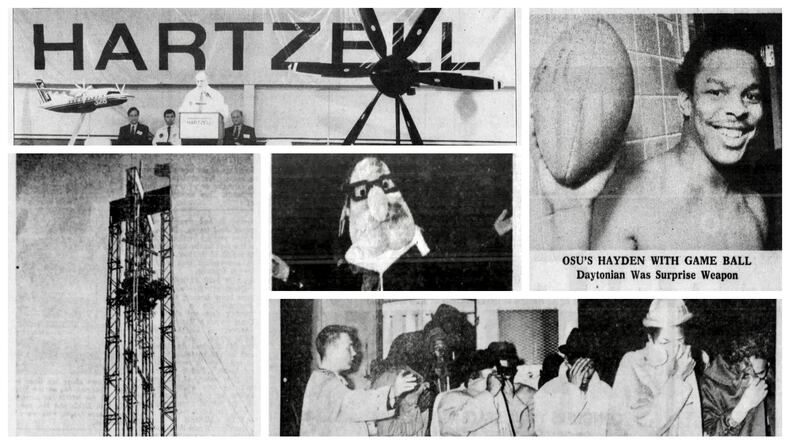Here’s a look at some stories from the week of Nov. 17-23.
Nov. 17, 1940: 151-foot steel tower for Deeds Carillon completed at old river
Structural steel work for the Deeds Carillon was completed, and an American flag was placed on the top — 151 feet above the base level.
Work on the unusual structure began on Oct. 10, 1940. The steel was erected in five sections, and the next step was to be setting the 64 diagonal components.
Work was also to begin on pouring the final concrete and then the laying of granite for the console room walls.
Although the carillon shaft towered 151 feet into the air, that didn’t tell the whole story of the structure. A 35 1/2-foot concrete foundation extends below ground, making the entire height of the carillon 186 1/2 feet. Thirteen feet of the main structure is encased in concrete.
The carillon rises 177 feet above Old River park and Carillon Historical park.
Nov. 18, 1960: Drug raid ruins $10,000 weekly take
After a long investigation, Dayton police officers arrested 31 people in a drug raid. It was reported that the drug dealers were making $10,000 per week selling heroin.
Under Ohio law at the time, possession of drugs could bring a 40-year sentence, and selling drugs provided a risk of 64 years in prison for a single sale.
Many of the drug users did not have enough cash to purchase the drugs, and bartering was involved in the deals.
One person brought $1,500 worth of stolen perfumes and clothing to trade.
Two other men offered a revolver, believed to have been used in an armed robbery that same night, in exchange for the narcotics.
Nov. 22, 1970: Daytonian plays big role in OSU victory over Michigan
Ohio State defeated Michigan 20-9 in 1970 to complete its second unbeaten season in three years, win the Big Ten Championship and a trip to the Rose Bowl game.
It was the first time in Big Ten history that both teams had reached the final game with perfect records.
Daytonian Leo Hayden had a career day. The running back had 28 carries for 117 yards. He scored the touchdown that put the game beyond Michigan’s reach in the fourth quarter.
Many of the crowd of 87,321 rushed the field during the final seconds of the game and the goal posts were ripped from the ground and carried off by students.
Nov. 23, 1980: UD adopts new mascot
The University of Dayton announced a new yet-to-be-named mascot in 1980.
The character, which looked like “an old barnstorming pilot from years gone by,” was part of a effort to get more fans involved in basketball games.
The character was developed though the ideas of several committees and a contest was being held to come up with a name for it.
Another part of the “Play Flyerball” promotion were Flyerball kits which were sold at the arena for $1. The kit consisted of a blue balloon-like punch ball, a folding megaphone, a wallposter, a bumper sticker and a kazoo.
Several items such as Flyer T-shirts and blue spirit towels were also sold at the arena.
The mascot was later named Rudy Flyer.
Nov. 17, 1990: Hartzell makes new prop for commuter planes
The Hartzell Propeller Co. of Piqua once produced wooden propellers for the Wright Brothers in 1917.
In 1990, they were introducing a graphite composite propeller for large commuter airliners.
Their new “HD Series” propeller could be installed on engines producing 1,800 horsepower or more.
Hartzell had 285 employees at the time and was a major supplier of propellers to the general aviation industry.
The company provided propellers for the Voyager two-person aircraft when it made its nine-day, non-stop, around the world flight in 1986.
About the Author






